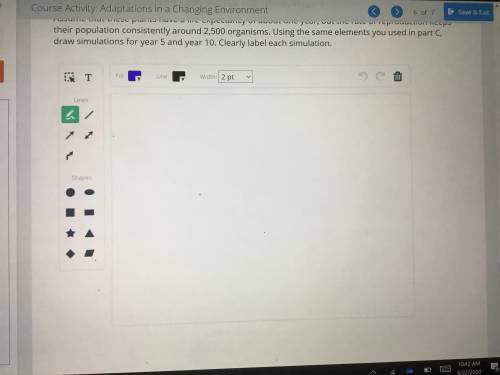
Biology, 23.06.2020 23:01 fufnun9757
Next, you’ll build a simulation based on what you think will happen because of natural selection. Here are two considerations: Some individuals with harmful characteristics can still successfully reproduce, but they have an overall lower chance of doing so compared to organisms with neutral or beneficial traits. Natural selection may affect distribution of traits. It’s possible that harmful traits could eventually disappear from the gene pool. Don’t worry about precise population numbers. Based on your understanding of natural selection, you’ll be modeling only one scientifically plausible trend that can occur. There are several correct variations of this diagram. You’ll explain the justification for your choices in part E. Assume that these plants have a life expectancy of about one year, but the rate of reproduction keeps their population consistently around 2,500 organisms. Using the same elements you used in part C, draw simulations for year 5 and year 10. Clearly label each simulation.


Answers: 2
Another question on Biology

Biology, 21.06.2019 19:40
Asmall number of finches are removed randomly from the wild and placed in a protected bird area. they are given as much food as they need and have plenty of space. why would natural selection not occur in this population? a. there is no reason for genetic mutation to occur. b. the birds compete for limited resources, c. the population has not reached carrying capacity. d. there is no genetic variation in the finches.
Answers: 1

Biology, 22.06.2019 08:30
Which component in a graph indicates an independent factor? a. y-axis b. x-axis c. scale
Answers: 2

Biology, 22.06.2019 16:00
Hydroelectric uses moving water to do work such as grinding grains in a mill true or false
Answers: 1

Biology, 22.06.2019 17:30
Sally, age 3 months, has a moist, red, vesicular rash on her cheeks, the backs of her hands, and her arms. her mother said sally was constantly trying to scratch the rash and often has difficulty sleeping. her father has a family history of allergic rhinitis and asthma. discussion questions. 1. review atrophic dermatitis from chapter 3 and discuss the pathophysiology of sally’s symptoms. 2. why is the father’s medical history significant, and what can sally expect as she grows up? 3. discuss the need to limit scratching, and describe practical methods to achieve this.
Answers: 3
You know the right answer?
Next, you’ll build a simulation based on what you think will happen because of natural selection. He...
Questions


Mathematics, 05.12.2019 06:31

Mathematics, 05.12.2019 06:31

Physics, 05.12.2019 06:31



Social Studies, 05.12.2019 06:31

Health, 05.12.2019 06:31


Biology, 05.12.2019 06:31

Business, 05.12.2019 06:31

Mathematics, 05.12.2019 06:31

Chemistry, 05.12.2019 06:31

Mathematics, 05.12.2019 06:31

Social Studies, 05.12.2019 06:31


Social Studies, 05.12.2019 06:31

Mathematics, 05.12.2019 06:31


Mathematics, 05.12.2019 06:31



